Chapter 12 - Divorce and Separation
In the United States, Marriage is the formal, state licensed and legal union between people whereas cohabitation is informal and based on simply sharing a residence. Outside of the U.S., most societies define marriage as being between a man and a woman or between a man and more than one women (Google "polygamy" with "Mormon splinter groups," "Muslim cultures," and "tribal cultures").
Notice that in modern societies, the state government claims the authority to grant marriage rights. This has not always been true for Western societies. A few centuries ago, tribal or clan leaders, a father, or elderly members of small groups could grant marriages. To legally marry in the United States today, one simply goes to the local county or state office and applies for a state marriage license. The state also claims authority in granting divorce rights to couples. To obtain a divorce one simply goes to the same or a similar county or state office and applies.
Divorce is the legal dissolution of a previously granted marriage. To understand marriage and divorce trends in the U.S., you should think in threes. In Figure 1 below you can see just how many legal marriages were granted per divorce for the years 2000-2011. These numbers are presented in a constant rate of events/1,000 population members. You can quickly see that there were twice as many marriages in 2000 as divorces (8.2 marriage and 4.0 divorce rates respectively). By the year 2011 marriage rates had declined to the degree that the rates were only 6.8 marriage and 3.6 divorce rates. Therefore, two marriages per one divorce (2 +1=3).
During those same years, the US population grew by 9.7 percent adding about (SOURCE). That meant an increase of over 29 million in the population ( see http://www.multpl.com/united-states-population/table ). Yet, both the actual rate and numbers of marriages declined and the rate and numbers of divorces declined over the same time period 2000-2011. What does this mean? You see, the US did have more people living in it in 2011, but fewer of them are marrying and those who are married were divorcing at a lower rate than before.
For decades, newscasters and educators have warned that one in two marriages "end in divorce." Sounds frightening, doesn't it? Is it true? Not really, since divorce never reached the actual 50 percent mark. Based on surveys of exactly how many people have ever been divorced in their lifetimes, most who study the family, specifically the divorce process will tell you that actual divorce risk are closer to 43 percent (see article called "Research on Divorce: Continuing Trends and New Developments" by Paul R. Amato in the Journal of Marriage and Family 72 (June 2010): 650 – 665; DOI:10.1111/j.1741-3737.2010.00723.x ).
Figure 1. Marriage and Divorce Rates in the US per 1,000 Population*

The U.S. Census Bureau conducts annual surveys of the U.S. population and publishes them as the Current Population Surveys. Most marriages last, and the odds are that divorce won't happen to most marriages. It is a myth that 1 in 2 marriages eventually ends in divorce. There are a few myths about U.S. divorce trends that will be dispelled in this chapter. You might have heard the myth of the "Seven-year Itch," where divorce happens prior to or shortly after the seventh year.

One recent study published by the Bureau of Labor Statistics looked at a scientifically obtained sample of the US population using a longitudinal tracking survey to follow their marital histories. They reported on the marriage outcomes of people who had reached the age of 46 in the US. The findings suggested that by age 46 there were 86.8 percent of the sample who had married and 53 percent were still married and 44.8 percent who had ever been divorced. Among those who had divorced, their first marriages lasted an average of 9.2 years; 65.7 percent of these divorced people remarried, taking an average of 4.3 years to remarry; and 62 percent of them were still in their second marriage. These second marriages lasted an average of 6.6 years(retrieved 24 June 2014 from Table 3. Marriage outcomes by age 46 by gender, race/ethnicity and educational attainment SOURCE ). Figure 2 shows the influence gaining and education has on marital experiences. In the blue bars, you can see the percent ever marrying which is the highest among those who graduated with their Bachelor’s degree or higher. The green bar shows the percent still in their first marriage and it is significantly higher for college graduates. The red bar shows the percent ever divorced which is significantly lower for college graduates. Without exception, the higher your education, the greater your marriage success.
Figure 2. Marital History from BLS Longitudinal Survey of Youth Year 1979*

It is realistic to assume that you will likely have an overall positive marriage that is likely to be a rewarding and enjoyable relationship. There is a catch though. Your marriage will be as positive and rewarding as each of you chooses it to be. The days of traditional marriage being supported by other social institutions such as: schools, religion, government, media, economy, education, and technology are long since gone (if they ever were fully supportive of it is still under debate). The responsibility for a rewarding and happy relationship, in which ever form you decide to experience it, depends almost exclusively upon your personal-level, ongoing, persistent, proactive, and devoted efforts toward the quality of the relationship.
We'll discuss these trends in divorce rates below, but first we must define cohort. A Cohort is a group of people who have some demographic characteristic, typically associated with their birth year or group of birth years. The Baby Boom is a cohort of those born between 1946 and 1964 and represents a never-before and never-after repeated high period of birth rates that yielded about 76.4 million living Baby Boomers today (retrieved 1 July 2014 SOURCE ).

In fact, according to one recent article, the Baby Boomers were responsible for the rise in divorce after 1970 and they continue to have higher divorce rates even though some are now retired. (see Kennedy, S. & Ruggles, S. (2014) Breaking up is hard to count: The rise of divorce in the United States 1980-2010. Demography Vol 51: p. 587-598, DOI 10.1007/s13524-013-0270-9). Part of the issue may be that first marriages have the highest rates of staying married. Divorce rates increase in 2nd, 2rd, etc. marriages and the baby Boomers have many previous marriages in their histories.
Figure 3 shows a more detailed description of U.S. divorce rates since 1940 and some of the factors that contributed to them. As you already noticed, divorce rates were relatively low prior to 1940. But, in the 1940s WWII was ongoing and divorce rates moved upward, with a one-year spike in 1946. As a reminder, keep in mind that 1946 was the United States' most unusual year for family-related rates. Divorce rates, marriage rates, birth rates and remarriage rates surged during this year while couples married at their lowest median age in U.S. history. Remember that the Baby Boom began in 1946.
After 1946, divorce rates fell to steady low levels and remained there until the 1960s, when they slowly began to rise. The Baby Boomers directly and indirectly influenced the rise of divorce rates. In 1964 the first group of Baby Boomers turned 18 and entered the U.S.'s 18-24 prime marriage market years. For the next two decades Baby Boomers added about 4 million men and women to the marriage market each year. Thus, Baby Boomers raised the numbers of married people and thereby the numbers at risk of divorcing.
Figure 3. United States Divorce Rates per 1,000 Population 1900-2009
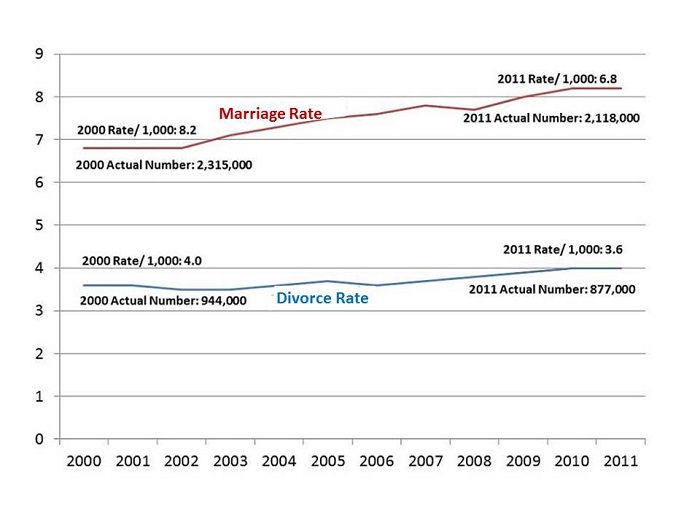
Directly, Baby Boomers contributed to the divorce rate. Baby Boomers and those immediately preceding them (born 1936-1945) have very high rates of divorce. Figure 4 shows that the experience of being currently divorced by age groups for the US in 2012. The highest rate of currently divorced people is also found among the women and men of the 50-59 cohort. The Baby Boomers 1946-1955 still hold the highest divorce rates of any cohort in U.S. history. Their unprecedented high divorce rates raised the overall divorce rates for the entire nation and contributed in part to the myth of half of all marriages ending in divorce. The oldest old have lower percentages of currently divorced in part because in their generation divorce was not so easily accepted as an option.
Figure 4. Percent Currently Divorced by Age Groups in the U.S. 2012 (with Baby Boomers highlighted)*

When scientists and government researchers predict the risks you might have of divorce, they use the experiences of currently married people who have and have not divorced -- therein lies part of the complication of deriving an "odds or risks of divorce" that we can have confidence in enough to offer advice to the soon-to-be-married. The U.S. has had its worst divorcing cohort ever, and some of them will likely divorce again before their death. The trend among younger marrieds is to remain married longer and divorce less . . . but, what if they collectively have an increase in their marital dissolution experiences? What if all of the sudden, millions and millions of currently married couples flock to the courthouse to file for divorce?
Odds of Divorce
First, that scenario isn't likely to happen because today's married couples tend to remain married. Second, and this is more important, the national risk of divorce is different from your personal risk of divorce in one crucial factor -- you have very little influence on the national rates and a great deal of influence on your own marriage quality and outcome. You and your spouse have much control over your marital experience; how you enhance it; how you protect it from medical, economic, and other stressors that can undermine it; and finally how you maintain it.
Family scientists refer to Marital Entropy as the principle based on the belief that if a marriage does not receive preventative maintenance and upgrades it will move towards decay and break down. Hearing an evening news report on national divorce trends has much less impact on your marriage than a preventative weekend away together to recharge your romance and commitment, which is a marital maintenance strategy designed to combat marital entropy. A proactive and assertive approach to your marital quality is far more influential than most other factors leading to divorce.
It is true that the longer a couple is married the lower their odds of divorce. Figure 5 shows a visual depiction of how the odds of divorce decline over time. The first 3 years of marriage require many adjustments for newlyweds. Of particular mention is the process of transitioning into a cohesive couple relationship with negotiated financial, sexual, social, emotional, intellectual, physical, and spiritual rules of engagement. Most couples have many of these negotiations in place by years 7-10. Anyone can divorce at any time in a marriage. Since longevity is often associated with the arrival of children, accumulation of wealth, establishment of acceptable social status (being married is still highly regarded as a status), and the buffering of many of life's daily stressors; the average couple finds it difficult and too costly to divorce, even though some features of the marriage are less than desirable (see Levinger's Model below).
Figure 5. Estimated Odds of Marriage Lasting Based on Number of Years Married

Using Social Exchange theory as a basis for understanding why couples stay married or divorced, you begin to see that spouses consider cost-to-benefits, rewards-punishments, and/or pros-cons in their decisions. Remember that Social Exchange Theory claims that society is composed of ever present interactions among individuals who attempt to maximize rewards while minimizing costs. Assumptions in this theory are similar to Conflict theory assumptions yet have their interactionistic underpinnings. Basically, human beings are rational creatures, capable of making sound choices when the pros and cons of the choice are understood.
This theory uses a formula to measure the choice making processes: (REWARDS - COSTS) = OUTCOMES or (What I get out of it - What I lose by doing it) = My decision. In 1979 Levinger and Moles published a chapter in a scholarly anthology wherein they discussed the rational choices made by spouses who were considering divorcing or remaining married. It's been referred to as "Levinger's Model." Levinger's Model looks like this in the formula: (Attractions - Barriers) +/- Alternative Attractions = My decision to stay married or divorce. Look at Table 1 below to see an example of how Levinger's Model clarifies the choices people might make and their perceived rewards and costs.
Table 1. Levinger's Model of Rational Choice in Divorce
| Attractions - Magnets = rewards that stem from being married | Barriers () +/- Walls = punishments or losses you'd face if you divorced. You'd have to climb over these walls if you divorced. | Alternative Attractions Lures Away From Your Marriage = something attractive that you could obtain if you were unmarried. |
|---|---|---|
| Positive Social Status | Loss of positive status and gain of new negative-status stigma of being divorced | Liberated status with freedom to explore relationships with others |
| Wealth Accumulation | Division of wealth (at least by half) | Opportunity to be disentangled from family costs |
| Co-parenting | Co-parenting with ex-spouse -- never truly free from this role | Shared custody, alleviating some degree of burden of parenting |
| Sex | Much less availability and predictability of sexual partner | Possibility of new sexual partner |
| Health Support and Stress Buffer | Loss of health support and additional stress from divorce process | Different types of stressors and relief from pre-divorce stresses |
| Stay Married Formula ↑Attractions | ↑Barriers | ↓Lures |
| Divorce Formula ↓Attractions | ↓Barriers | ↑Lures |
You can see that Levinger's Attractions are simply the magnets or rewards that stem from being married. These are the payoffs or rewards that come from being married and include positive social status, wealth accumulation, co-parenting, sexual intercourse, and the health support and stress buffer that marriage typically brings to each spouse. Levinger's Barriers are simply the costs or punishments that might be incurred if a married person chose to divorce. These might include losing all the attractions and magnets, changing to a negative status, suffering a division of wealth, co-parenting at a distance and without same-household convenience, experiencing a change/decline in sexual frequency and predictability, and losing the health and stress buffer that married couples enjoy (even unhappily married couples experience some measure of this buffer).
Levinger's Alternative Attractions are basically lures or something appealing that a now-married spouse might find rewarding if he or she goes ahead and divorces. These might include liberation and the freedom that comes from being single (albeit divorced) and newly available on the market, a financial disentanglement from the ex-spouse and at times child care (this view is especially common among men, who often share custody but pay less in the end for their children), alleviation of parenting when children are with other parent, freedom from unwanted sexual demands and/or possibility of new sexual partner or partners, and abandonment of overbearing stressors from marriage.
I personally have been studying the family for nearly 30 years and have seen trends in divorce that reflect the collective society according to Levinger's model. I've also seen the cases of my personal friends. In one case a mother of four left the marriage and let her ex have full custody, full parental responsibility, and full homemaking under stressful psychological and emotional duress for the children. In her case, the lure of an online Dungeons and Dragons gamer with evening real-world roles and escapades offered her an appealing alternative to her perceived mundane mothering routines.
I've also seen the case of a father of three who left the marriage and forfeited any responsibility, refusing to pay court-ordered child support and refusing to spend time with his children (the state garnished his wages). In his case he had a series of girlfriends, a new truck, and a no-rent bedroom in his mother's home. This while his ex-wife was forced onto welfare and has not left poverty these last 14 years since the divorce. The lure for this man was a second childhood of pleasures and self-interests. Generally speaking, some people find high school reunions, online matchmaking, and the singles social scene to be an appealing lure. Others are more interested in alleviating undesirable and at times even hostile marital living conditions.
Look at the last two rows in Table 1. They show how you can use a formula to understand the propensity a couple has to divorcing or staying married. In the Stay Married formula, the Attractions and Barriers are high while the lures or low. Translated into Social Exchange thinking, there are many rewards in the marriage with many barriers that would prove more punishing if a spouse wanted to divorce. At the same time there are few lures that might draw a spouse away from the marriage.
The Divorce formula is also revealing. Attractions are low, barriers are low, and lures are high. In other words, there are few rewards from being married, low barriers or low perceived punishments from divorcing, and high lures to draw a spouse away from the marriage. One would expect satisfied couples to have the Stay Married formula while dissatisfied couples would have the Divorce formula. By the way, the formula is only descriptive (it tells the state of the union) and not predictive (it cannot tell you what the couple might do). Some with the Divorce formula in place remain married for years. A few with the Stay Married formula become dissatisfied and begin focusing on lures.
One Social Exchange principle that clarifies the rational processes experienced by couples is called the concept of equity. Equity is a sense that the interactions are fair to us and fair to others involved by the consequences of our choices. For example, why is it that men who work 40 hours a week and have a wife who works 40 hours a week do not perform the same number of weekly hours of housework and childcare as their wives? Scientists have surveyed many couples to find the answer. Most often, it boils down to a sense of fairness or equity. Because she defines it as her role to do housework and childcare while he doesn't, because they tend to fight when she does try to get him to perform housework, and because she may think he's incompetent, they live with an inequitable arrangement as though it were equitable (don't get me started on the evidence that supports men sharing the actual roles of housekeepers and childcare providers -- see Joseph Pleck, "Working Wives/ Working Husbands," Sage Pub, CA).
Figure 6 shows a list of more and less commonly used divorce rates. We have already discussed the Crude Divorce rate, Refined Divorce Rate, Proportion Divorced, and Percent Ever Divorced. The adult Divorce rate is much less commonly used because in the United States, most who marry are already 18 and older.
Figure 6. Annual Divorce Rates Used by Statisticians for Given Population (e.g., the United States)
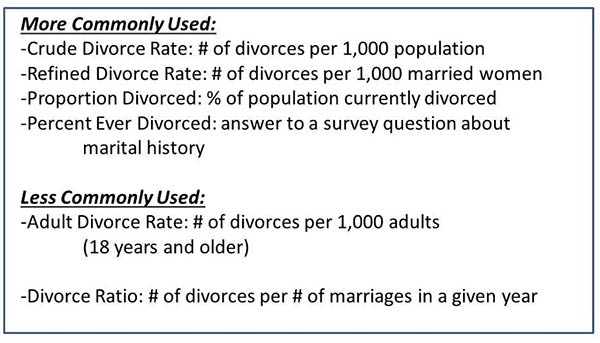
What Predicts Divorce in the U.S.?
Years and years of research on divorce yielded a few common themes of what puts a couple at more or less risk of divorce. Before we discuss those factors, let me point out an uncomfortable truth: all of us are at risk of dying as long as we are alive; likewise, all of us are at risk of divorcing as long as we are married. But, the presence of divorce risks does not imply the outcome of divorce. There is a geography factor of U.S. divorce. Divorce rates tend to be lower in the Northeast and higher in the West. Nevada typically has the highest of all state divorce rates, but it is often excluded from comparison because of the "Vegas marriage" or "Vegas Divorce" effect.
Figure 7 shows the higher divorce rate in Nevada, the U.S. average, and the lower divorce rate in Massachusetts. Nevada’s divorce rate has actually declined from its high of 11.4/1,000 population in 1990 down to 6.7/1,000 in 2009. Massachusetts has slightly declined from 2.8/1,000 down to 2.2/1,000. Notice that the overall divorce rate in the US also decline from 4.7/1,000 down to 3.4/1.000 for the same years.
Figure 7. United States Divorce Rates per 1,000 Population, US, Nevada, & Massachusetts 1990-2009*
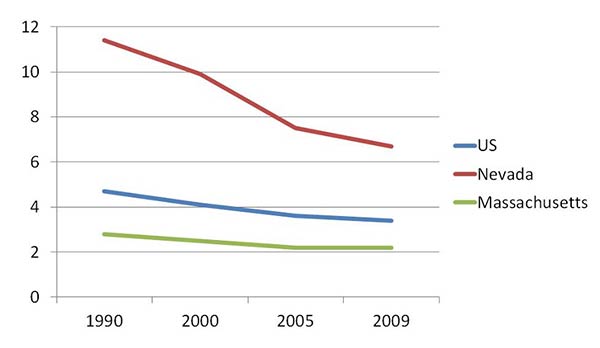
Every state, from Colorado West to the Pacific Ocean has a higher than US average divorce rate (Except California stopped reporting its divorce rate). The divorce rate has almost always been higher in the Western US and lower in the North Eastern US. Geography and the cultures associated within its boundaries matters. It’s more difficult to change the culture of your state than it is to make personal adaptations within your own marital relationship. Figure 8 shows some of these individual-level choices a married person can make to reduce his or her divorce risk.
Figure 8. Factors Associated with Divorce and/or Long-term High Quality Marriage
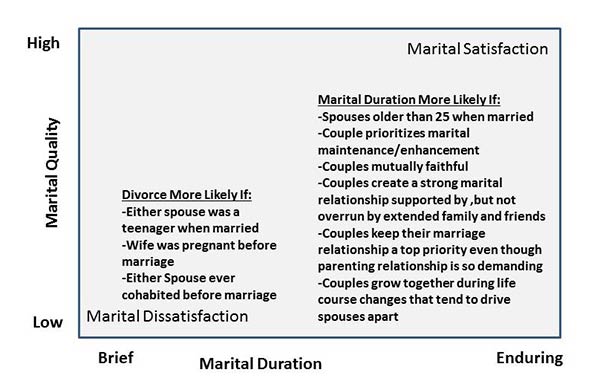
Most of the factors that contribute to divorce lie to a great extent within the realm of influence and choice had by the individual. For example, waiting until at least your 20th birthday to marry lowers divorce risks tremendously. In fact the best ages to marry are 25-29 (interestingly, the U.S. median age at marriage for men and women falls within this age group). Being 15, 16, 17, 18, or 19 years old at your first marriage is extremely risky. Why? Basically the explanation falls under these types of issues: they are disadvantaged economically, socially, and emotionally; their circumstances have accompanying hardships that would not be present had they waited to age 25 (for example, had they graduated college first and prepared themselves for the labor force and for the emotional complexity of marriage); many scientific studies indicate that there is a refining process of social and intellectual capacities that is not reached until around age 26; and young marriers exchange their prime years of self-discovery (adventure) for marriage.
Another major individual-choice-related factor is marrying because of an unplanned pregnancy. Most babies born in the U.S. are born to a married couple. But today about 40 percent are born to single mothers of all ages. Even though many of these single mothers marry the baby's father, numerous studies have indicated that they have a higher likelihood of their marriage ending in divorce.
Many individuals struggle to completely surrender their single status. They mentally remain on the marriage market in case "someone better" than their current spouse comes along. Norval Glenn in 1991 argued that many individuals see marriage as a temporary state while they keep an eye open for someone better: "More honest vows would often be "as long as we both shall love" or "as long as no one better comes along" (p. 268). Glenn gets at the core of the cultural values associated with risks of divorcing. (See Norval D. Glenn, "The Recent Trend in Marital Success in the United States," Journal of Marriage and the Family, Vol. 53, No. 2 (May, 1991), p. 261-270)
Robert and Jeanette Lauer are a husband-wife team who have not only studied the family but have written a college textbook called Marriage and Family: The Quest for Intimacy (2009, Cengage). They studied the commitment and endurance of married couples. They identified 29 factors among couples who had been together for 15 years or more. They found that both husbands and wives reported as their number 1 and 2 factors that "My spouse is my best friend" and "I like my spouse as a person" (see Robert Lauer, 1986, 'Til Death Do Us Part: How Couples Stay Together,and also Google "Lauer and Lauer" and "Kerr" various years). The Lauers also studied the levels of commitment couples had to their marriage. The couples reported that they were in fact committed to and supportive of not only their own marriage but marriage as an institution.
Irreconcilable differences are common to marriage, and the basic strategy to deal with them is to negotiate as much as is possible, accept the irresolvable differences, and finally live happily with them.
Keeping a positive outlook on your marriage is essential. As was mentioned above, as long as a couple is married they are technically at risk of divorce. But not all divorce risks are created equally. Newly married couples in their first ten years have a great deal of adjustment to work through, especially during the first 36 months. They have new boundaries and relationships to establish. They have to get to know one another and negotiate agreements about the who, what, why, and how of their day-to-day lives together. The longer they stay together, the lower their risks of divorce.
Family Scientists have borrowed from the physics literature a concept called entropy, which is roughly defined as the principle that matter tends toward decay and reduction, toward its simplest parts. For example, a new car if parked in a field and ignored would eventually decay and rot. A planted garden if left unmaintained would be overrun with weeds and pests and would yield low if any crop. Couples who take ownership of their marriage and who realize that marriage is not bliss and that it often requires much work, experience more stability and strength when they nurture their marriage. They treat their marriage like a nice car and become committed to preventing breakdowns rather than waiting to repair them. These couples read and study experts like Gottman, Cherlin, Popenoe, Amato, Hawkins, and others who have focused their research on how to care for the marriage, acknowledging the propensity relationships have to decay if unattended.
A positive outlook for your marriage as a rewarding and enjoyable relationship is a realistic outlook. Some couples worry about being labeled naïve if they express the joys and rewards their marriage brings to their lives. Be hopeful and positive on the quality and duration of your marriage, because the odds are still in your favor. You've probably seen commercials where online matchmaking websites strut their success in matching people to one another. There have been a few criticisms of online marital enhancement services, but millions have used them. Along, with DVDs, talk CDs, self-help books, and seminars, there are many outlets for marital enhancement available to couples who seek them. Very few know that there is now a website that offers support to marrieds who want to be proactive and preventative in their relationship. Check it out at SOURCE.
"Doomed, soaring divorce rates, spousal violence, husbands killing wives, decline of marriage," and other gloomy headlines are very common on electronic, TV, and print news stories. The media functions to disseminate information, and its primary goal is to make money by selling advertising. The media never has claimed to be random or scientific in its stories. They don't really try to represent the entire society with every story. In fact, media is more accurately described as biased by the extremes, based on the nature of stories that are presented to us, the viewers.
Many media critics have made the argument for years that the news and other media use fear as a theme for most stories so that we will consume them. As you observed above, most in the U.S. choose marriage, and most who are divorced will eventually marry again. True, marriage is not bliss, but it is a lifestyle preferred by most U.S. adults. From the Social Exchange perspective, assuming that people maximize their rewards while minimizing their losses, marriage is widely defined as desirable and rewarding. There are strategies individuals can use to minimize the risks of divorce (personal-level actions). Table 2 below lists 10 of these actions.
Table 2. Ten Actions Individuals Can Take to Minimize the Odds of Divorce
- Wait until at least your 20s to marry. Avoid marrying as a teenager.
- Don't marry out of duty to a child. Avoid marrying just because she got pregnant. Pregnancy is not a mate-selection process we discussed in the pairing-off chapter.
- Become proactive by maintaining your marriage with preventative efforts designed to avoid breakdowns. Find books, seminars, and a therapist to help you both work out the tough issues.
- Never cohabit if you think you might marry.
- Once married, leave the marriage market -- avoid keeping an eye open for a better spouse.
- Remain committed to your marriage. Most couples have irreconcilable differences and most learn to live comfortably together in spite of them.
- Keep a positive outlook. Avoid losing hope in your first 36 months -- those who get past the three-year mark often see improvements in quality of marital relationship, and the first 36 months have the most intense adjustments in them.
- Take the media with a grain of salt. Avoid accepting evidences that your marriage is doomed -- this means being careful not to let accurate or inaccurate statistics convince you that all is lost, especially before you even marry.
- Do your homework when selecting a mate. Take your time and realize that marrying in your late 20s is common now and carefully identify someone who is homogeneous to you, especially about wanting to be married.
- Focus on the positive benefits found to be associated with being married in society while learning to overlook some of the downsides.
Finally, decades of studies have indicated that a history of cohabitation (ever having cohabited) contributes to higher likelihood of divorce. Cohabitation has been studied extensively for the last two decades, especially in contrasting cohabiting and married couples. Clear findings consistently show that cohabiting and marriage are two different creatures (see studies by Lawrence Ganong and Marilyn Coleman). Those who cohabit tend to establish patterns of relationships that later inhibit marital duration. In other words, people who cohabit and then later marry are much more likely to divorce than those who never cohabited.
As mentioned before, cohabitation is more common in the U.S. today than ever before. Cohabiters are considered to be unique from those who marry in a variety of ways, yet the similarities between married and cohabiting spouses suggests that their lifestyles overlap. In both lifestyles, relationships are formed and often ended. Cohabiters have more than twice the risks of their relationship ending than do marrieds (see Andrew J. Cherlin, 2008, "Multiple Partnerships and Children's Well-being," Austrian Institute of Family Studies, No. 89, p. 33-36).
Cherlin also discussed the uniqueness of cohabiting versus married couples. In sum, cohabiters often feel financially ill-equipped to marry, have lower expectations of relationship satisfaction than do marrieds, and often expect a shorter relational duration than marrieds. Cherlin's main thesis of this article is the stability for children when adult intimate relationships end.
Effect on Children
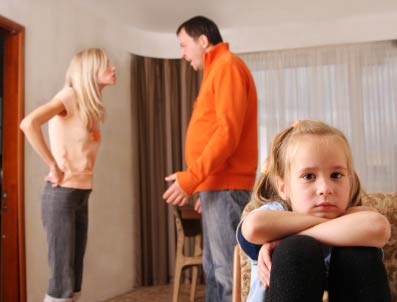
Let's think for a minute about what is best for children in terms of their parents remaining married or divorcing. Every home should provide a safe, loving, and nurturing environment where basic needs are met and where children are nurtured into the greatness of their potential. Sounds ideal, huh? But that's not the real-world experience of most children. Familial stresses and hardships are the norm. Being a child of divorced parents does not imply that you are in some way worse off than children whose parents remain married yet facilitated a harsh and destructive home environment for their children.
Divorce is a blessing/positive life change for many children and their parents. In fact, some children of divorce are very happily married in their own adult relationships because of their sensitive searching for a safe and compatible partner and because they don't want their children to suffer as they themselves did. At the same time, having a parent who divorced probably increases the odds of divorce for most children. Judith Wallerstein has followed a clinical sample of children of divorce for nearly four decades. Her conclusions match those of other researchers -- children whose parents divorce are impacted throughout their lives by it in a variety of ways. The same could be said of children whose parents remained married and raised them in a caustic home environment. Figure 9 shows that millions of U.S. children have experienced their parents' divorces since 1960, with nearly 1 million new children of divorce each year.
Figure 9. United States Estimates of Numbers of Children Involved in Parents' Divorce 1960-2006 and divorce rates from 1960-2008*
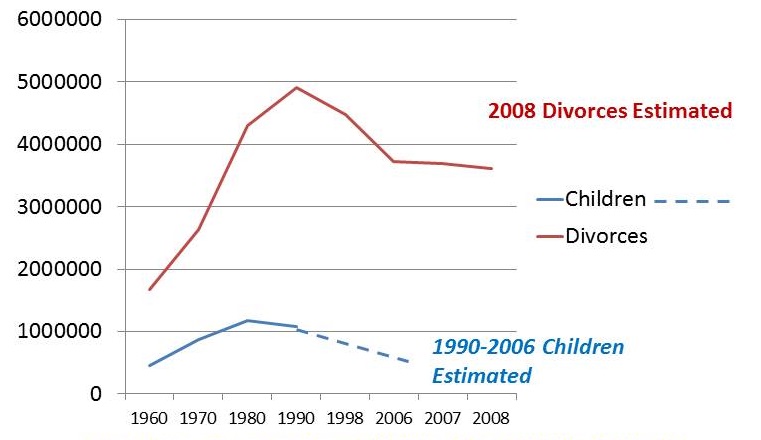
Whenever a couple divorces (or separates, for cohabiters), children experience changes in the stability of their lives at many levels. Many of these children have been through divorce more than once. When their parent’s divorce, children often assume blame for it and believe that they should try to get their parents back together (like in Walt Disney's Parent Trap movie). In reality, the children typically don't influence their parents' choices to divorce directly -- children are certainly part of the equation, but they are rarely the sole cause of divorce. On top of that, divorce brings change, which is stressful by its very nature. Children worry about being abandoned. They have had their core attachment to their parents violated. They become disillusioned with authority as they try to balance "the way things ought to be" with "the way things actually are." They become aware of ex-spouse tensions and realize that they themselves are the subject of some of these tensions.
It is better for children to be forewarned of the coming divorce. As they discuss their concerns with you, listen and reassure. Make it clear to children that they are not the cause of divorce and that both parents still love them and will always be their parent. Tell and show them that they will be taken care of as best a parent can. Show them that even though divorce is difficult, you can work together to get through it. Show them that you and the absent parent will learn to get along and they will too. It's tempting, but ensure that they don't have to serve as messenger or go-between or in any other way assume the burdens associated with the dissolved marriage. Table 3 presents some core guidelines for divorcing parents.
Table 3. Core Guidelines for Divorcing Parents
- Respect each other, get along, and come to terms with the nuances of co-parenting (both parents and their new partners will be at the kindergarten play).
- Set up and maintain predictable routines, especially following mandates in the divorce settlement decree.
- Take mediation and adhere to mediation guidelines.
- Get professional help for children when needed.
- Ensure the constant safety and well-being of your children.
- Follow a mutually agreed upon divorce decree.
- Help children remember the good times that happened before the divorce.
- Expect children to act out in unexpected ways, and work with ex-spouse on being consistent and agreeing on how to discipline consistently. Encourage children to have a strong relationship with both parents.
- Get your own professional help, and guard against your children becoming caregivers to you.
- Take a co-parenting course to learn how to get along for the sake of the children.
Additional Reading
Search the keywords and names in your Internet browser
Decreasing divorce by strengthening marriages SOURCE
7 Steps to Deciding if Divorce is right For You SOURCE
Article Divorce: It’s Way Bigger Than We Thought SOURCE
Divorce and Separation SOURCE
General Divorce Information SOURCE
Divorce Has a Lasting Toll on Health SOURCE
Article Broken Home, Broken Boys SOURCE
How Single Motherhood Hurts Kids SOURCE
Article The War On Poverty at Age 50 SOURCE
Article The New Unmarried Moms (20 Somethings) SOURCE
Article Why Boys Are Falling Behind SOURCE
Article Real complex relationship between single motherhood and crime SOURCE
Article The Fragile Family Effect SOURCE
Ideas for spicing up your relationship
10 Ways to Show Your Wife You Care SOURCE
10 Ways to Show Your Husband You Care SOURCE
Video-5 Tips To Save Your Marriage SOURCE
Marriage Transitions
Does Divorce Make People Happy?: Findings From a Study of Unhappy MarriagesSOURCE
Should I Try to Work it Out? SOURCE
Research-based Online Marriage Counseling Alternative SOURCE
Marriage Map SOURCE
Why Change SOURCE
Remarriage
6 Reasons to Remarry After Divorce SOURCE
Marriage After Divorce SOURCE
10 Tips For Those Considering Remarriage SOURCE
Secrets To A Successful Second Marriage SOURCE
11 Reasons to Give Marriage Another Shot After Divorce SOURCE
How Divorce Works SOURCE
Remarriage and Blended Families SOURCE
Defusing The Family Feud SOURCE
Family Studies SOURCE and/or SOURCE
Helpful Strategies to Deal with Ex-Partners in Remarriages SOURCE
Parenting After Divorce
Parenting Plan for Divorced Parents University of Missouri SOURCE
Parenting Apart University of Tennessee SOURCE
The Truth About Children and Divorce by Robert Emory, Ph.D. SOURCE
Resources for Divorcing Parents Lincoln, Nebraska SOURCE
Developing a Parenting Plan: U. of Missouri article SOURCE
Smart Marriages SOURCE
20 Marriage Tips Everyone Needs to Know SOURCE
The "Five Love Languages" Defined SOURCEThe 5 Love Languages free profile/test SOURCE
Marriage Research
5 Marriage Myths, 6 Marriage Benefits SOURCE
A Glimpse at the Marriage and Divorce Statistics for Utah SOURCE
Cohabitation, Marriage, Divorce and Remarriage in the U.S. SOURCE
Linking Religion, Divorce Rate Faulty SOURCE
The Costly Consequence of Divorce SOURCE
Time, Sex, and Money: The First Five Years of Marriage SOURCE
Does Divorce Make People Happy? Findings from a Study of Unhappy Marriages SOURCE
Stepfamily Relations
Utah’s United Way 211 (Directory of where to go in your community for specific marriage and family support services) SOURCE
Smart Steps for Step Families Class SOURCE
Step-Parenting: The Non-Biological Parent SOURCE
Managing Stress in Stepfamilies SOURCE
Creating Rituals in Stepfamilies SOURCE
National Stepfamily Resource Center (NSRC) is a national, nonprofit membership organization dedicated to successful stepfamily living. This site provides educational information and resources for anyone interested in stepfamilies and their issues. (Formerly the Stepfamily Association of America (SAA)) SOURCE